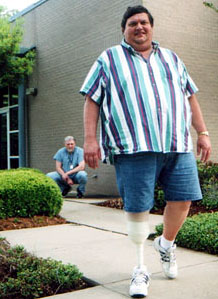FLOWOOD, Miss.—For Reggie Methvin, hearing a doctor suggest that he should consider an amputation of his right leg below the knee was a good thing.
After his heel was severely fractured in a fall off a ladder in December 1999, the Brandon resident hobbled around on crutches for nearly two years with a chronic draining infection before he found a physician who realized that an amputation and prosthetic leg would probably bring an end to the pain and give him back the one thing he coveted more than anything else—the ability to walk without aid.
Orthopedic surgeon Dr. Thom Tarquinio introduced Methvin to Rick Psonack, director of orthotics and prosthetics at Methodist Rehabilitation Center. Psonack and his staff showed Methvin around the Jackson hospital’s state-of-the-art orthotics and prosthetics laboratory in Flowood and explained to him what his options were.
“I call it the showroom where they keep all the legs and arms,” Methvin recalled. “It was a great learning experience to see the newest technology and find out that I didn’t have to be in pain all the time.”
Methvin met Brad Kennedy and Jamie McPherson, both technicians at Methodist Rehab’s east campus in Flowood who not only design and fit prosthetic limbs but are also amputees themselves.
“Those guys had prosthetic legs and were talking about playing basketball and going to the gym and I was thinking, ‘Man, I just want to walk again.’”
Since his injury, Methvin had needed to treat his injured leg each day, administering several doses of intravenous medication to fight an infection. When after two years he still wasn’t better, he sought new opinions.
After his visit with Psonack and his orthotics and prosthetics team, Dr. Tarquinio, a foot and ankle specialist and an associate professor of orthopedic surgery at the University of Mississippi Medical Center, performed an amputation of his right leg below the knee.
While he was still under anesthesia, Psonack fitted Methvin with a special post-operative prosthetic leg. When he awoke, he wasn’t shocked to see his leg missing. “I reached down around my knee and felt my leg and went back to sleep,” he recalled.
“A lot of patients who go through an amputation have mental obstacles to overcome. Sometimes it’s tough to get used to the idea of not having your leg anymore,” explained Psonack. “The post-operative prosthesis helps the patient mentally. The patient wakes up after surgery and looks down to see two legs and two feet. It makes a difference and there’s not as much down-time between the amputation and the time when we can start working on walking again.”
Three months after the surgery, Methvin walked the one-fourth mile around his block on his prosthetic leg without assistance. “If I’d known after the injury what I know now,” Methvin said. “I would have had them remove the leg in the first place.”
And that seems to be a problem, explained Psonack. Lack of information prevents many with crippling injuries from reaching their potential.
“For a long time, physicians seem to have viewed an amputation as a defeat,” he said. “But now doctors have been working with us and are starting to see some of the success our patients are having. They’re starting to see this as the next logical step on the road to recovery for some patients.”
Dr. Tarquinio agrees that an amputation following a severe injury, such as sustained by Reggie Methvin, should not necessarily be viewed as a failure of treatment, but often represents the fact that all injuries aren’t reconstructable. It often comes down to the patient’s feelings about losing a limb, he added. “Some patients will do anything to keep their foot, and that is a personal decision. But from my position, even if after several surgeries we are able to cure the infection in a wound like Mr. Methvin’s, there is still no guarantee that the foot will be as functional as a prosthesis would be.”
Since being fitted with the prosthetic leg, Methvin’s health has continued to improve, he said. “I’m getting better and better now. Before the amputation, I felt like I was getting worse and worse.
“Dr. Tarquinio and Rick and the technicians at the Flowood lab were the first people to give me hope,” Methvin said. “That helped me more mentally than anything.”
In Methvin’s case, the results of his decision meant getting his life back on track faster than continued treatment of his wound and additional surgeries would have, if that had worked at all. Now, he’s back at his job working behind a desk rather than out on a ladder.
“He was more interested in getting back to a functional life,” said Dr. Tarquinio. “He’s back to work and he’s enjoying himself. And that’s the goal of what we do as care providers.”
For Psonack, seeing patients re-discover their independence is both motivation and reward for the time that goes into his work.
At Methvin’s last Thanksgiving dinner, he fixed his own plate for the first time in two years. “I’ve been having to let someone else fix my plate for me, but this year I stood up and told them to get out of the way so I could get my own food,” he said.
“I’m so happy now, I feel like a new man.”

